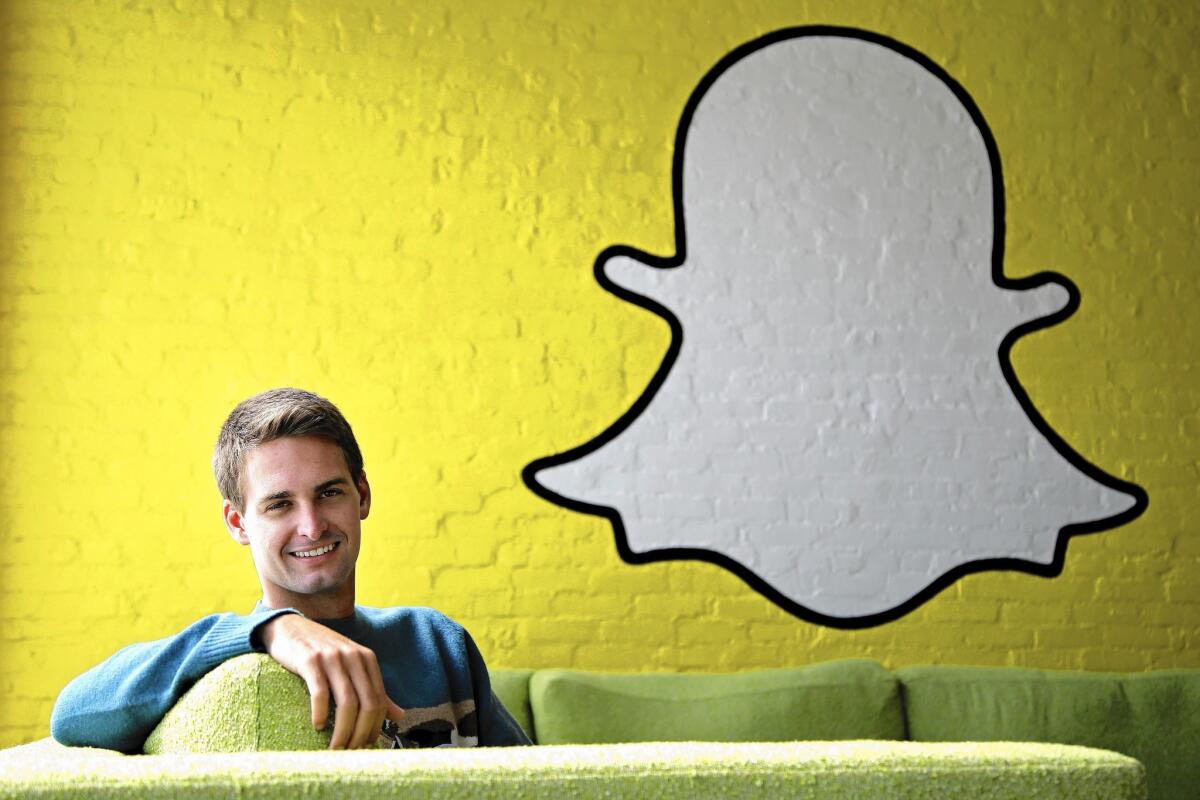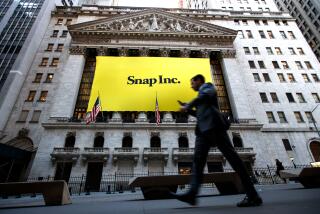Snapchat holds the line on targeted ads, but big brands are pushing for more

Snapchat Chief Executive Evan Spiegel said the company’s ad offerings are still in the early stages, but its philosophy is to not allow “creepy” targeting.
A stunning 100 million people use Snapchat every day, and advertisers are demanding more access to them.
But more than a year after rolling out its first ad, Snapchat still doesn’t have a clear ad strategy. The Venice company has frustrated advertisers by resisting one of the industry’s most popular and lucrative tools: targeted advertising, which shows users ads based on their unique browsing histories and interests.
Chief Executive Evan Spiegel said the chat and video-sharing app’s ad offerings are still in the early stages, but the company’s philosophy is to not allow “creepy” targeting. He is trying to balance what users want with what advertisers expect.
Big brands, including Coca-Cola, Toyota and W Hotels, have experimented with Snapchat ads because they couldn’t pass up the easy chance to market to a large segment of highly coveted young consumers. But several advertisers have warned that they won’t increase their Snapchat budgets without more enhanced targeting tools or data about the ads’ effectiveness.
“I don’t know if you can push … very far if you don’t have the data,” said Douglas Kwong, digital director at restaurant chain CiCi’s Pizza, which ran an ad on Snapchat in July. “Otherwise, you’re throwing money for impressions. It’s a shot in the dark.”
If Snapchat continues to limit advertisers from tapping its valuable user data, ad industry experts say the company’s revenue potential is limited.
Facebook, Google and Pinterest allow a more personalized ad experience, displaying ads for, say, ankle boots to an avid fashionista or video games to a hardcore gamer — a strategy that has proved more cost-effective to drive quick sales than showing everyone the same ads.
But targeting has angered consumers and privacy advocates who complain that the companies are collecting too much personal information. Snapchat says it wants to carve out its own path to profits, one that won’t alienate its users.
It’s a delicate balance that many young tech companies have grappled with. Snapchat, now 41/2 years old and valued privately at $16 billion, needs more revenue if it wants to eventually have a successful IPO; the company doesn’t disclose revenue figures. This summer, Fidelity Investments marked down its stake in Snapchat by 25%, leading to speculation that investors may have been overzealous in valuing the start-up so highly.
A Snapchat spokeswoman said the company is listening to advertisers and “continuously searching for innovative solutions.” The company declined to elaborate.
The ad industry is being transformed as people ditch TV for apps, an inherently more personal experience that relies heavily on tracking consumers’ every swipe and tap.
Ads by far are Snapchat’s top revenue generator, with companies paying roughly $100,000 for regional ad packages and upward of $500,000 for national coverage. (Snapchat also charges users to replay self-destructing messages and access image-altering software.)
But without leveraging users’ likes, friendships and viewing histories to target ads, Snapchat’s growth might stall.
“They are going to need more revenue to support the evolution of the product,” said Jeremy Simon, director of partnerships and business development at social media agency Attention Global. Ad targeting, he said, is “the way all the platforms eventually end up going.”
Snapchat ranked last in return on ad investment and targeting capabilities out of six big social apps in a recent EMarketer survey; Facebook, Instagram, Twitter, Pinterest and LinkedIn all scored better. Another report from the research firm, which surveyed ad executives, listed increased targeting as digital advertisers’ No. 1 priority as they buy $170 billion in online ads worldwide this year.
Snapchat hasn’t rejected targeting outright. It’s allowing it selectively: For instance, by letting alcohol brands such as Bud Light and Jim Beam show ads only to users older than 21 based on birth dates entered when creating accounts.
Companies such as Sprite, Jack in the Box and CoverGirl have used Snapchat to advertise only to users in a certain city or store. Other targeting options include reaching only iPhone owners, for example, or just women (based on evolving methods of guessing users’ gender).
But advertisers want more. They say Snapchat is too cautious and could easily harvest more information and expand ad options.
Companies would love to show ads related to what users are conversing about on Snapchat. They’re eager to sync their user databases to Snapchat’s to market to likely customers. They’d like to be able to target members of specific political parties. At the very least, they want to be able to link to their websites.
“We don’t want to do the spaghetti approach of throwing everything against the wall,” said one political advertiser who spoke on the condition of anonymity to not jeopardize a nascent relationship with Snapchat. “With more back-end integration … a platform with that many users and open to advertisers can become effective.”
So far, Snapchat’s solution to blunt the creepiness of targeting has been to turn ads into usable app features, such as digital stickers that promote a movie, retailer or event. Brands pay for the “sponsored geofilter” stickers, which users select to decorate photos.
About 4.7 million people nationwide opted to use a geofilter that General Electric sponsored for a day in June, with nearly 64 million users seeing the ad. This week, GE is promoting a geofilter to users at 75 airports and train stations in the U.S.
More traditional ad options include skippable 10-second video ads, shorter than video ads on competing apps. Advertisers can safely bet on who they will reach because the ads appear in between user-generated videos on specific subjects or interspersed among content from a particular media brand, such as BuzzFeed or CNN; some videos are visible only to people in a certain geographic area.
Recently, Toyota directed Corolla ads at Los Angeles users for several weeks in a daily Snapchat video about the region’s events. But the automaker “unfortunately” couldn’t judge whether the spending was worth it because of the limited audience data, said Cliff Atkinson, interactive communication director at ad agency Saatchi & Saatchi LA, which helped manage the campaign.
All Atkinson could decipher was that the Snapchat ad provided an “incremental” benefit. That’s because the ads reached consumers who probably didn’t notice what tracking firm ISpot.tv said were $26 million worth of similar TV ads.
Broadly connecting with that young Snapchat user base has been good enough for some — for now.
“Snapchat has earned their keep at the table in terms of options we think about,” said Emmanuel Seuge, senior vice president for content at Coca-Cola North America, a major Snapchat advertiser. “They are learning how far they can go [with targeting] and what that fine line is.”
Twitter: @peard33







